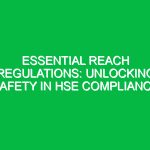Introduction
REACH, an acronym for Registration, Evaluation, Authorization, and Restriction of Chemicals, is a critical piece of legislation enacted by the European Union aimed at protecting human health and the Environment from the risks posed by chemicals. Within the domain of Health, Safety, and Environment (HSE), REACH Regulations serve as a cornerstone for ensuring that chemical substances are managed safely throughout their lifecycle—from production to disposal. This article delves into the nuances of REACH, exploring its significance in HSE compliance and how organizations can navigate these regulations effectively.
Understanding REACH Regulations
The REACH regulation was adopted in 2006 and came into force in 2007. Its primary goal is to ensure that chemical substances do not adversely affect human health or the environment. The regulation mandates that manufacturers and importers of chemicals must register their substances with the European Chemicals Agency (ECHA), providing comprehensive data on their properties and uses.
To break it down, the REACH framework consists of four main components:
- Registration: Companies must register substances manufactured or imported in quantities of one tonne or more per year. This involves submitting data on the chemical’s properties, its uses, and any associated risks.
- Evaluation: The ECHA evaluates the submitted registrations to assess whether the data provided is sufficient and whether the risks from the substance are adequately managed.
- Authorization: Certain substances deemed to pose significant risks may be subject to authorization. This means that companies must apply for permission to continue using these substances.
- Restriction: REACH allows for restrictions on the manufacture, placing on the market, or use of certain hazardous substances to protect human health and the environment.
Understanding these components is crucial for HSE professionals as they ensure compliance and promote Safety within their organizations.
The Relevance of REACH in HSE Compliance
REACH regulations directly impact HSE compliance in several ways:
- Risk Management: By enforcing stringent data requirements for chemical substances, REACH helps organizations identify and mitigate risks associated with chemical exposure. This proactive approach is fundamental in maintaining Workplace Safety.
- Transparency: REACH promotes transparency in the chemical supply chain, allowing downstream users to understand the risks of chemicals they may be exposed to. This transparency is vital for effective Safety Measures and emergency preparedness.
- Environmental Protection: The environmental implications of chemical use are profound. REACH regulations emphasize the need for sustainable practices, encouraging organizations to seek safer alternatives where possible.
Navigating the complexities of REACH can seem daunting, but understanding its requirements can lead to significant Benefits in Safety, compliance, and overall operational efficiency.
Key Components of REACH Regulations Relevant to HSE
To ensure effective HSE compliance under REACH regulations, organizations must familiarize themselves with several key components:
1. Registration Process
The registration process is the first step for companies involved in the production or importation of chemicals. To register, a company must compile a dossier containing information on the chemical’s identity, properties, uses, exposure scenarios, and risk management measures. This dossier must be submitted to the ECHA, which evaluates the data for completeness and accuracy. Companies must also keep this information updated, reflecting any changes in the use or risk management of the chemical.
2. Safety Data Sheets (SDS)
Safety Data Sheets are crucial documents that provide information on the properties of a chemical, including its Hazards, handling, storage, and emergency measures. Under REACH, suppliers must provide SDS to downstream users, ensuring they have access to vital safety information. An effective SDS not only aids compliance but also plays a key role in risk assessment and management in HSE.
3. Chemical Safety Assessment (CSA)
A Chemical Safety Assessment is a comprehensive evaluation of the risks posed by a chemical substance. It involves assessing the exposure scenarios, identifying risk management measures, and ensuring that the chemical can be used safely in various applications. Conducting a CSA is essential for companies dealing with substances that require registration and aids in demonstrating compliance with REACH.
4. Authorization and Restrictions
Certain substances classified as Substances of Very High Concern (SVHC) may require authorization before they can be used. Organizations must keep abreast of the ECHA’s list of SVHCs and understand their obligations regarding these substances. Additionally, restrictions may apply to certain hazardous substances, necessitating changes in processes or materials used in operations.
Challenges of Complying with REACH Regulations
Despite the benefits of REACH, compliance poses several challenges for organizations:
- Resource Intensiveness: The process of gathering data, conducting assessments, and preparing registrations can be time-consuming and resource-intensive, particularly for small and medium-sized enterprises (SMEs).
- Complexity: The technical nature of the information required for registration and evaluation can be overwhelming, especially for companies without dedicated resources for regulatory compliance.
- Continuous Changes: The regulatory landscape is constantly evolving, with new substances being added to the SVHC list and updates to existing regulations. Staying informed about these changes can be a challenge.
To address these challenges, businesses should consider investing in Training for their staff or partnering with consultants who specialize in REACH compliance.
Real-Life Implications of REACH Regulations
To illustrate the real-world implications of REACH, consider the case of a European manufacturer of electronic components. This company previously used a specific chemical in its production processes. Upon assessing the chemical under REACH regulations, they discovered it was classified as an SVHC. Consequently, they applied for authorization to continue using the chemical but were ultimately denied due to available safer alternatives.
This situation forced the company to innovate, leading to the development of a new, safer material that not only complied with REACH but also improved product performance. This example highlights how REACH, while initially seen as a regulatory burden, can drive innovation and improve Workplace Safety.
Best Practices for Navigating REACH Regulations
To ensure compliance with REACH regulations and promote a safe working environment, organizations can implement the following Best Practices:
- Conduct Regular Training: Regular training sessions for employees on REACH compliance and chemical safety can empower them to manage substances responsibly.
- Maintain Up-to-Date Registrations: It is vital to keep all registrations current, reflecting any changes in chemical use, risks, or Safety Measures.
- Engage with Suppliers: Collaborate with suppliers to ensure they provide all necessary safety data and comply with REACH requirements.
- Utilize Technology: Invest in software solutions that can help manage chemical inventories, track compliance, and maintain documentation efficiently.
- Stay Informed: Regularly review updates from the ECHA and industry associations to stay abreast of any changes to REACH regulations.
Implementing these practices can significantly enhance an organization’s ability to meet REACH requirements and ensure a safer working environment.
Conclusion
In conclusion, REACH regulations play a pivotal role in safeguarding human health and the environment from the risks associated with chemical substances. For HSE professionals, understanding and navigating these regulations is not just a compliance necessity but also a pathway to fostering a culture of safety and Sustainability.
By embracing the principles of REACH, organizations can enhance their operational efficiency, drive innovation, and ultimately contribute to a healthier planet. As the landscape of chemical regulation continues to evolve, staying informed and proactive will be essential for achieving HSE compliance and ensuring the safety of all stakeholders involved.


